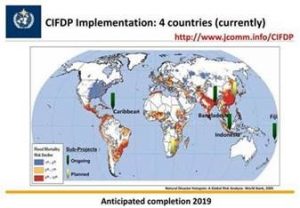
Every 23 March, the World Meteorological Organization (WMO) commemorates the coming into force of the Convention establishing the World Meteorological Organization in 1950. The WMO is a specialised agency of the United Nations (UN) responsible for promoting international cooperation on atmospheric science, climatology, hydrology and geophysics and serves as a forum of gathering and free exchange of weather data and research to six member territories and 193 member states in which Fiji is a member to.
World Meteorological Day 23 March 2022 therefore has the theme “Early Warning and Early Action”, and spotlights the vital importance of Hydrometeorological and Climate Information for Disaster Risk Reduction (World Meteorological Organization, 2022).
Here is the Working Group II (WGII) contribution to the Intergovernmental Panel on Climate Change (IPCC) Sixth Assessment Report (AR6) released in 2021; which assesses the impacts of climate change, looking at ecosystems, biodiversity, and human communities at global and regional levels. It also reviews vulnerabilities and the capacities to adapt to climate change.

Source: IPCC Sixth Assessment Report WGII
The United Nations’ climate science research WGII, concluded that it is “unequivocal” that humans have warmed the skies, waters, and lands, and that “widespread and rapid changes” have already occurred in every inhabited region across the globe. The IPCC predicts 1.5 degrees will see extreme heatwaves, oceans rising, and the destruction of 70 -90% of coral reefs. This is why the 1.5 figure is so important.
Given the current scenario and early warning signs of climate change, greater coordination between national meteorological and hydrological services, disaster management authorities and development agencies are fundamental to better prevention, preparedness and response.
WMO’s vision is that “by 2030, we will see a world where all nations, especially the most vulnerable, are more resilient to the socioeconomic consequences of extreme weather, climate, water and other environmental events.
The theme of World Meteorological Day builds momentum towards this vision as WMO and its 193 members work together towards a safer, more resilient and sustainable planet. Indeed 2030 – just eight years from now – is the key date in the global agenda to make the world a better place.
It is the target year to achieve the 17 Sustainable Development Goals, the Sendai Framework for Disaster Risk Reduction and the Paris Agreement on Climate Change. All are interlinked.

Pacific Community (SPC) is committed to assist Pacific Island countries with strengthening their early warning systems and weather forecasting mechanisms for sustainable development. As part of this effort, SPC developed a coastal inundation-forecasting tool for WMO Coastal Inundation Forecasting Demonstration Project (CIFDP) in Fiji.
This tool was demonstrated in the Coral Coast before being replicated in other areas within Fiji including the Nadi River catchment in 2017. The CIFDP aims to build a multi-hazard early warning operational forecasting system – using oceanographic and hydrological evidence – to provide flood forecasts for areas at risk of inundation from both ocean and river sources.
Further action from CIFD project, Fiji Meteorological Service (FMS) and Disaster Management Office (DMO) implemented the Flash Flood Guidance System (FFGS), which provides guidance to the FMS’s weather experts to generate and issue operational flash flood forecasts and warnings with improved lead-time and sites’ specific.
To conclude, early action, or anticipatory action or forecast-based action, means taking steps to protect people before a disaster strikes based on early warning or forecasts. To be effective, it must involve meaningful engagement with at-risk communities and being prepared and able to act at the right time, in the right place, can save many lives and protect the livelihoods of communities everywhere, both now and in the future.]
At the Fiji National University, (FNU) the College of Engineering, Science and Technology’s (CEST) Department of Meteorology and Environmental Science offers programmes related to atmospheric sciences, climate studies and resource management at Bachelor’s and Post Graduate levels. For more information, visit www.fnu.ac.fj or email EO-Sciences@fnu.ac.fj
Adimaitoga William Rabuku
Assistant Instructor
Department of Meteorology and Environmental Science
College of Engineering, Science and Technology
Fiji National University
References
Pörtner, H. O., Roberts, D. C., Tignor, M., & Polo, E. S. (2022). IPCC Climate Change: Impacts, Adaptation, and Vulnerability. Contribution of Working Group II to the Sixth Assessment Report of the Intergovernmental Panel on Climate Change. IPCC.
WMO. (2019). “Members of Regional Association V (South-West Pacific)”. World Meteorological Organization.
World Meteorological Organization. (2022, March 9). Retrieved from World Meteorological Organization: https://public.wmo.int/en/resources/world-meteorological-day
World Meteorological Organization. (2022, March 9). Retrieved from Flash Flood Guidance System with Global Coverage (FFGS): https://public.wmo.int/en/projects/ffgs
World Meterological Organization. (2022, March 9). Retrieved from https://public.wmo.int/en/projects/coastal-inundation-forecastingdemonstration-project-fiji-cifdp-f-development-of-integrated